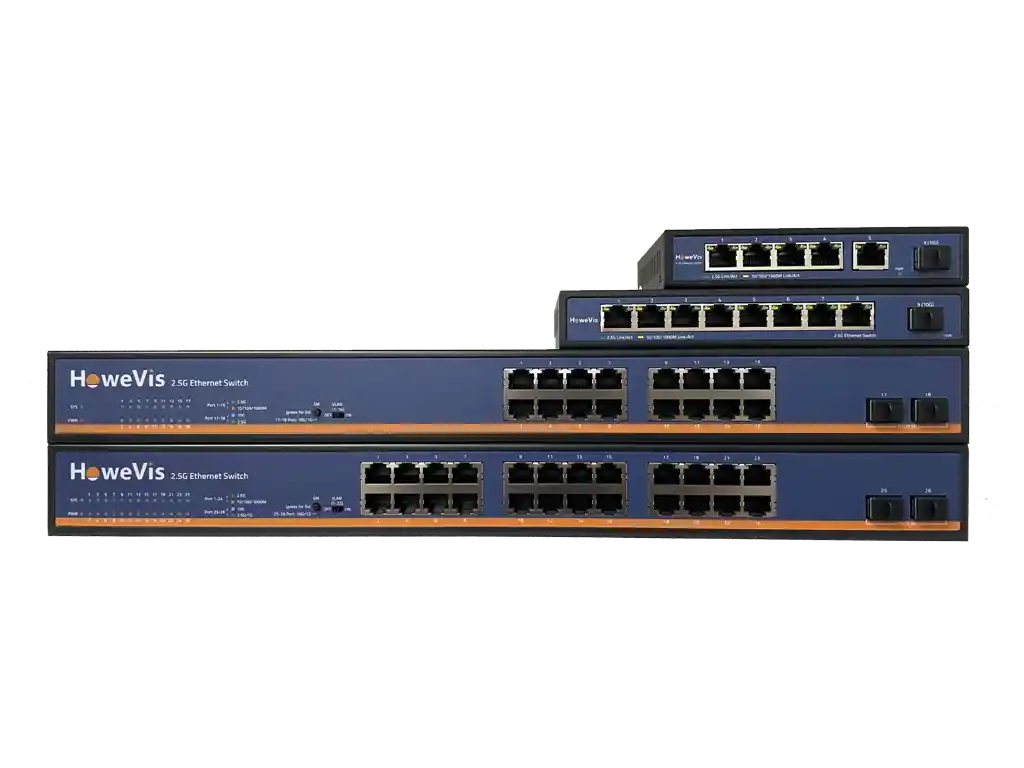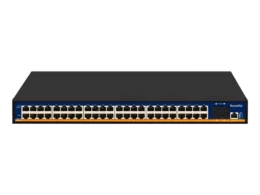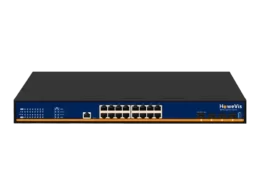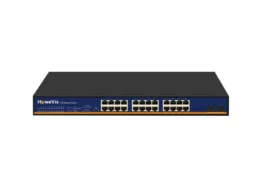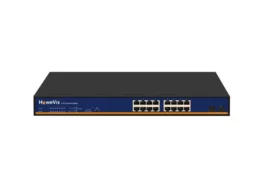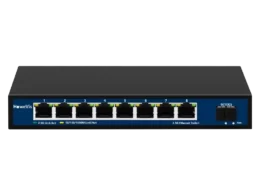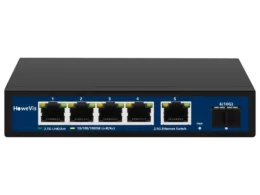As a professional network engineer, I’ve seen firsthand how crucial a robust networking setup is for any tech-savvy environment. The 2.5G Ethernet switch stands out as a game-changer, offering speeds that can significantly boost your network’s efficiency without breaking the bank. My journey with this device began when I integrated it into our office’s network, witnessing an immediate improvement in data transfer rates and overall performance. This review dives deep into its features and performance and why it could be missing when optimizing your customer network setup. By sharing my expertise and experience, I aim to highlight how this switch can meet the demands of modern networks, ensuring you make an informed decision on whether it’s the right fit for your needs.
5 Ports 2.5G Enterprise Ethernet Switch with 10G SFP+ (Model: SW60501TF)
2.5G Switch Summary
The 2.5G Ethernet switch delivers enhanced network performance across five ports with its 2.5G Ethernet speeds. It also features a 10G SFP+ port, making it ideal for high-speed uplink or NAS connectivity in a network switch. Furthermore, this switch is designed to work seamlessly with various devices thanks to its compatibility with various IEEE standards, ensuring broad support across different network setups.
| Specification | Value |
| I/O Interface | |
| Ethernet | 5×2.5G RJ45 Ports, 1x10G SFP+ Port |
| Performance | |
| Bandwidth | 45Gbps |
| Pack forward rate | 33.48Mpps |
| VLAN | 4096 |
| MAC address | 4K |
| Jumbo Frame | 12Kbytes |
| Transfer mode | Storage & forward |
| MTBF | 100000 Hours |
| Standard | |
| Network protocol | IEEE802.3, IEEE802.3u, IEEE802.3ab, IEEE 802.3bz, IEEE 802.3z, IEEE 802.3ae, IEEE802.3x |
| Industry-standard | EMI: FCC Part 15 CISPR (EN55032) class A, EMS: EN61000-4-2 (ESD), EN61000-4-5(Surge) |
| Network Medium | 10Base-T: Cat3, 4, 5 or above UTP/STP(≤100m), 100Base-TX: Cat5 or above UTP/STP(≤100m), 1000Base-TX: Cat5 or above UTP/STP(≤100m) |
| Optical Medium | multi-mode: 50/125, 62.5/125, 100/140um, Single mode: 8/125, 8.7/125, 9/125, 10/125um |
| Certificate | CE, FCC, RoHS |
| Environment standard | |
| Working Temperature | -10~50°C |
| Storage Temperature | -40~70°C |
| Working Humidity | 10%~90%, non-condensing |
| Storage Humidity | 5%~90%, non-condensing |
| Power voltage | Adapter input voltage: AC 100-240 V, switch input voltage: DC 12V1A |
| Indicator | PWR (Power), 1-5 Port green light, 1-5 Port yellow light |
| Physical specification | |
| Structure size | Product Size: 140x93x28mm |
| Package Size | 203x160x55mm |
| Product Net-Weight | 0.33KG |
| Product Gross-Weight | 0.46KG |
| Packing info | |
| Carton size | 580x335x445mm |
| Packing Qty | 40pcs |
| Packing weight | 19.5KG |
| Packaging list | Switch 1pcs, User manual 1pcs, Certificate 1pcs, Power adapter 1pcs |
| Order Info | SW60501TF |
Benefits of Multi-Gigabit Networking
The move towards multi-gigabit networking isn’t just a trend; it’s a significant leap forward in handling data. With the increasing demand for faster internet speeds due to more devices connecting to networks and higher bandwidth-consuming activities, having a 2.5G ethernet switch can be a game-changer.
For starters, the increased speed is immediately noticeable. I remember the first time I upgraded my network to include a 2.5G ethernet switch; downloading large files and streaming high-definition videos became much smoother and quicker. It was like moving from a crowded street into an open highway.
Moreover, this technology supports the growth of smart homes and offices. As we connect more devices – from smart TVs and phones to IoT devices like thermostats and security cameras – the need for higher-speed networking becomes critical. The 2.5G ethernet switch ensures enough bandwidth for all these devices to operate efficiently without lag or interference.
However, it’s not all sunshine and rainbows. The initial setup can be daunting for those who are not tech-savvy, and the cost might be higher compared to traditional gigabit switches. But considering the long-term benefits of having a faster and more reliable network, it’s an investment worth making.
Regarding compatibility, most new devices are built to support multi-gigabit speeds, but older devices may not fully benefit from this upgrade. This means you might need to consider updating some hardware to ensure you get the full advantages of your network upgrade.
Another aspect worth mentioning is how multi-gigabit networking can future-proof your setup. With internet speeds only expected to increase in the coming years, having a network that can handle more than the standard 1Gbps is a wise decision. It ensures that you won’t need another upgrade anytime soon.
Understanding 2.5G vs 10G switch
Understanding the difference between 2.5G and 10G switches is crucial when considering a network upgrade. The main distinction lies in their speed capabilities. A 2.5G switch can handle up to 2.5 Gigabits per second per port, a significant boost from the standard 1G without needing cable upgrades.
On the other hand, a 10G switch provides even higher speeds, up to 10 Gigabits per second, catering to environments with heavier data demands. However, it’s important to note that achieving these speeds might require upgrading your cabling infrastructure.
From my experience, a 2.5G switch fits perfectly in scenarios where increased bandwidth is needed without the cost of extensive infrastructure changes. It’s ideal for small businesses or home networks looking to enhance their speed for streaming or file-sharing tasks.
Conversely, I found that a 10G switch is more suited for enterprise environments or data centers where large volumes of data are transferred frequently. The higher speed significantly reduces transfer times and improves overall network efficiency.
One critical consideration is compatibility with existing devices and cables. While many newer devices support 2.5G connectivity, not all do, so it’s essential to check before deciding. Similarly, while some existing cables can support 10G speeds, others may need to be replaced to avoid bottlenecks.
Furthermore, cost plays a significant role in deciding between these two options. Generally speaking, 10G switches are more expensive than their 2.5G counterparts due to their higher speed capabilities and advanced features designed for larger-scale operations.
Key Features
When considering a network upgrade or setup, the 2.5G Ethernet switch stands out for its blend of speed and efficiency. This device caters to the increasing demand for faster data transfer rates and ensures compatibility with various IEEE standards, making it a versatile choice for different networking environments.
The inclusion of 5*2.5G RJ45 ports alongside a 10G SFP+ port provides a significant boost in performance over traditional Gigabit switches. This configuration allows for high-speed connections across multiple devices without bottleneck issues, ideal for environments with expected data-intensive tasks.
From my experience, the auto MDI/MDIX support is a game-changer. It simplifies network setup by eliminating the need for crossover cables, making it easier to connect devices like computers and printers directly to the switch without additional equipment.
The advanced port indicator lights are conducive for troubleshooting. They offer immediate visual feedback on the status of each connection, which has saved me time and frustration when identifying connectivity issues.
Enhanced surge protection is another critical feature. In areas prone to electrical surges, this switch provides an extra layer of security for connected devices. I’ve witnessed firsthand how sudden power spikes can cripple unprotected networks, leading to costly downtime and repairs.
However, no product is without its drawbacks. While this switch offers impressive features, it lacks Power over Ethernet (PoE) support. This might be a deal-breaker for setups relying heavily on PoE devices like IP cameras or VoIP phones, requiring additional equipment to power these devices.
5×2.5G RJ45 ports plus 1dx10G SFP+ port
Having five 2.5G RJ45 ports on a switch significantly boosts its capability for connecting multiple devices at high speeds. This feature is especially beneficial in environments where several devices simultaneously require fast, reliable connections. For instance, I’ve connected my desktop, laptop, smart TV, and two gaming consoles simultaneously in my home office setup without experiencing any lag or decreased performance.
Adding a 10G SFP+ port takes this switch’s functionality to another level. It allows for connection to high-speed networks or devices like NAS systems, which are crucial for tasks requiring high data transfer rates. Connecting my NAS system through the 10G SFP+ port resulted in significantly faster access to stored files and smoother backup processes.
These features are game-changers for both home and small office environments. The ability to connect multiple devices at 2.5G speeds caters well to the growing demands of modern homes filled with smart devices and gaming systems. Similarly, small offices benefit from the enhanced productivity of faster data transfers between computers, servers, and storage solutions.
However, it’s important to note that to utilize this switch’s capabilities fully, your devices must support 2.5G or higher speeds. While this wasn’t an issue in my setup since most of my devices were compatible, it might be a limiting factor for those with older technology.
Compliance with Multiple IEEE Standards
This 2.5G ethernet switch adheres to several IEEE standards, including the critical 802.3bz for 2.5GBase-T. This compliance is not just a technical formality; it guarantees broad compatibility with many network devices and protocols.
Understanding these standards can be daunting, but in my experience, this compliance has meant seamless integration into various network setups. I’ve connected devices that were years apart in terms of technology, and they communicated without a hitch because they all respected these standard language rules set by the IEEE.
The importance of these standards extends beyond mere compatibility. They ensure that every device connected to the network operates efficiently and reliably. For instance, adherence to IEEE 802.3x ensures effective flow control, preventing data loss during high-traffic periods—a scenario I’ve encountered more than once during large file transfers across the network.
Moreover, these standards are vital for maintaining network integrity and performance. They dictate how data is transmitted and received, ensuring that the switch can handle not just current networking demands but future ones as well. My setup includes a variety of devices, from gaming consoles to home servers, and this switch has managed them all without compromising speed or stability.
Auto MDI/MDIX Support
Auto MDI/MDIX is a feature that might not catch your eye initially, but its impact on network setup cannot be overstated. This technology allows the ethernet switch to detect the cable type connected to each port automatically. Whether you’re using straight-through or crossover cables, the switch intelligently adjusts without any manual input required from you. This simplification in network setup is a game-changer, especially for those not deeply versed in networking intricacies.
The elimination of the need for crossover cables is another significant advantage. Traditionally, connecting devices directly or networking devices of the same type required specific types of cables to facilitate communication. With Auto MDI/MDIX support, this requirement is tossed out the window. You can use any standard ethernet cable lying around, reducing both setup complexity and additional costs associated with purchasing different types of cables.
From my experience, this feature made setting up a home network involving various devices—routers, computers, and gaming consoles—significantly easier. I didn’t have to worry about having the correct cable type on hand; it was plug-and-play simplicity. This seamless connectivity extends beyond just ease of setup; it ensures that devices communicate efficiently without needing manual configuration adjustments.
The benefit extends to various scenarios, whether you’re setting up a small home network or managing connections between multiple devices in a small office environment. Auto MDI/MDIX support affords versatility and adaptability, meaning that your network can grow or change without necessitating an overhaul of your cabling infrastructure.
Advanced Port Indicator Lights
The port indicator lights on the 2.5G Ethernet switch are not just for show; they convey essential information about link status and activity. These lights tell you at a glance whether a connection is active and if data is being transmitted or received. This feature proves invaluable when setting up your network, ensuring every device is correctly connected and functioning as intended.
In my experience, these visual indicators have been a lifesaver during troubleshooting. When I encountered connectivity issues in my network, a quick look at the indicator lights immediately pointed me toward the problem port. Instead of sifting through complex logs or running numerous diagnostic tests, I could focus on resolving the issue with the specific connection indicated by the lights.
Moreover, these lights offer an ongoing advantage for monitoring network performance. By observing the lights’ pattern and color, you can get real-time insight into how much data is flowing through your network and if any ports are experiencing errors. This immediate feedback allows for swift actions to optimize performance or fix emerging issues before they escalate.
However, it’s important to note that while these lights provide valuable insights, they require some fundamental understanding to interpret correctly. Initially, I referred to the manual to remember what each light pattern meant. Over time, though, recognizing these patterns became second nature.
Enhanced Surge Protection
The surge protection provided by this 2.5G Ethernet switch is designed to shield connected devices from unexpected voltage spikes. This feature is critical in preventing damage to the switch and any connected devices, ensuring that your network remains operational despite electrical disturbances.
In my experience, areas prone to lightning storms or with unstable power supply can significantly benefit from this level of protection. I once lost a whole setup due to a lightning strike that fried everything connected to my previous, less-protected switch. Since upgrading to this model with enhanced surge protection, I’ve had peace of mind during thunderstorms and erratic power fluctuations.
This robust surge protection safeguards your equipment and extends the lifespan of the switch and connected devices. By mitigating the risk of damage from electrical surges, you’re not just protecting your current investment but potentially saving money on replacements and repairs in the long run.
This feature cannot be overstated for those living or working in areas where electrical fluctuations are common. It offers an added layer of security that could mean the difference between a minor inconvenience and a major disaster.
Buying Guide
When selecting a 2.5G Ethernet switch, the number of devices you plan to connect is crucial. I’ve found that underestimating this can lead to unnecessary bottlenecks and performance issues. It’s about the devices you have now and those you might add. For instance, I started with three devices in my setup but quickly expanded to five, pushing the limits of my initial switch choice.
Another key factor is assessing whether you need a 10G uplink port. This is particularly important if you plan on expanding your network or anticipate needing higher data throughput. In my case, opting for a switch with a 10G uplink was a game-changer, allowing me to integrate high-speed storage solutions without any hassle seamlessly.
Advanced features like Auto MDI/MDIX support and enhanced surge protection offer added value that shouldn’t be overlooked. From personal experience, Auto MDI/MDIX eliminates the frustration of cable type errors, making setup and expansion much simpler. Meanwhile, enhanced surge protection has saved my equipment during unexpected power surges, proving its worth many times.
The suggestion of others 2.5G switch model
In exploring high-speed networks, it’s crucial to consider options catering to varying scales and demands. The 8-port 2.5G switch with 1 port 10G SFP emerges as a formidable choice for small—to medium-sized enterprises or advanced home setups. This model strikes a balance between ample connectivity and uplink capacity.
Including a 10G SFP port is beneficial for scenarios requiring high-bandwidth uplinks to NAS systems or aggregation switches. It ensures that the network backbone isn’t a bottleneck, allowing devices connected at 2.5G speeds to leverage their capabilities without congestion fully.
Transitioning to larger setups, the 16-port 2.5G switch with 2-port 10G SFP caters well to environments where numerous devices demand more than gigabit speeds. This could include creative media production studios or research labs with significant data throughput needs. The dual 10G SFP ports offer redundancy and increased uplink capacity, ensuring smooth operation even under heavy load.
The 24-port 2.5G switch with 2-port 10G SFP stands out for organizations or communities with extensive networking requirements. It’s designed for users who need to connect many high-speed devices while maintaining robust uplink connections. My experience using this model in a collaborative workspace highlighted its ability to handle simultaneous high-volume data transfers efficiently.
However, it’s important to note that the network’s complexity increases as the number of ports increases. While these switches are generally plug-and-play, optimizing performance might require some networking knowledge, especially when configuring VLANs or QoS settings.
Final Remarks
Navigating the world of 2.5G Ethernet switches can feel like a maze. But with the right info, you’re set to make a choice that amplifies your network without breaking the bank. We’ve explored the essentials—from why multi-gigabit networking matters to picking a switch that ticks all your boxes. Remember, it’s not just about speed; features like surge protection and compliance with IEEE standards play a big role in what makes a switch stand out.
Ready to level up your network? Consider the key points we’ve covered and how they align with your needs. Whether for home use or powering a small office, the perfect 2.5G switch is out there. Don’t settle for less; go for a switch that offers reliability, speed, and peace of mind. Dive in, and let’s get those speeds soaring!
Frequently Asked Questions(FAQ)
What is a 2.5G Ethernet switch?
A 2.5G Ethernet switch supports network speeds up to 2.5 Gigabits per second on its ports, offering faster data transfer rates than standard Gigabit switches.
How does a 2.5G switch, offering gigabit speeds for efficient ethernet and speed network connections, differ from a 10G switch, designed for higher connection speed?
A 2.5G switch provides intermediate speeds between Gigabit and 10G, making it ideal for environments that do not require full 10G speeds or where budget and cable limitations exist.
What are the key features of the SW60501TF network switch model, including issues, regulatory markings, and notes?
The SW60501TF model boasts 2.5G RJ45 ports plus 110G SFP+ port, supports various IEEE standards, and offers auto MDI/MDIX, advanced indicator lights, and enhanced surge protection.
Does the SW60501TF support Power over Ethernet (PoE)?
No, the SW60501TF does not support PoE functionality.
Can I connect devices with different speeds to this switch?
Yes, the Ethernet ports on this switch are self-adaptive, supporting speeds of 10/100/1000M/2.5G, allowing devices with varying speed capabilities to be connected.
What type of surge protection does the SW60501TF offer?
It offers superior surge protection, with the standard mode at 6KV, ESD Air at 8KV, and contact at 6KV, safeguarding your network equipment from electrical surges.
Is there an alternative model to the SW60501TF for multi-gig networking?
Yes, other models supporting multi-gig networking are available; however, specific alternatives depend on your precise requirements, such as port count or additional features like PoE support.
